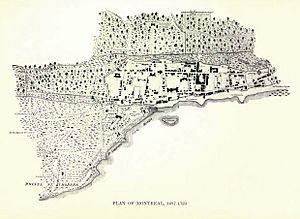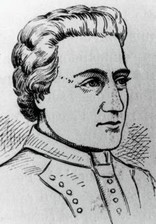Lachine massacre facts for kids
Quick facts for kids Lachine massacre |
|||||||
|---|---|---|---|---|---|---|---|
| Part of King William's War | |||||||
 Map of Montreal, 1687 to 1723. The Lachine settlement was located southwest of Montreal proper. |
|||||||
|
|||||||
| Belligerents | |||||||
| Mohawk | |||||||
| Strength | |||||||
| 1,500 Indians | 375 regulars and settlers | ||||||
| Casualties and losses | |||||||
| 3 killed | 250 killed | ||||||
The Lachine massacre was a surprise attack that happened on August 5, 1689. About 1,500 Mohawk warriors attacked the small French settlement of Lachine, which was located on Montreal Island in New France.
This attack was part of the Beaver Wars, a series of conflicts over control of the fur trade. The Mohawk people were upset because the French were moving into their lands. They were also worried about a French attack in 1687 led by the Marquis de Denonville. Settlers from New England encouraged the Mohawk to attack. They hoped it would weaken New France during King William's War.
During the attack, the Mohawk warriors burned down much of Lachine. They captured many people and killed around 240 settlers.
Contents
Why the Attack Happened
The Mohawk and other Iroquois groups attacked the French and their native allies for several reasons. These reasons were both about their way of life and their economy.
Cultural Reasons
Europeans in North America started trading furs with native groups, including the Iroquois. Beaver furs were very popular. In the 1600s, the French tried to control more of the fur trade, which made their relationships with native groups worse.
The French also tried to get native people to adopt French customs and religion. This meant giving up their own traditions, which many resisted. Some Mohawk people, for example, didn't like that French missionaries were changing their traditional society. However, they still needed to trade with the French. This cultural pressure increased tensions.
The relationship between the French and the Iroquois had been difficult for a long time. The French also had alliances with other tribes, like the Abenaki, for trade and war.
After a war in 1679, the Iroquois started raiding villages in the West. They claimed hunting grounds in the Ohio Valley. They kept these areas empty so they could hunt there. The Iroquois often attacked trading groups in these western areas, which were protected by the French.
In 1684, the Iroquois made a peace treaty with the French Governor, Antoine Lefèbvre de La Barre. This treaty said the Iroquois could attack western native groups. However, the French King didn't like this treaty. He replaced La Barre with the Marquis de Denonville. Denonville was less understanding of native relations. The Iroquois attacked the French partly because they didn't want to stop fighting their traditional enemies.
Another important reason for native warfare was "mourning wars." These wars were fought to get revenge for wrongs or to replace people who had died in a community. When new diseases like smallpox killed many native people, survivors would go to war to capture new members and rebuild their communities.
Economic Reasons
The Iroquois mainly wanted a better share of the fur trade, not war. To punish the Iroquois for attacking French fur traders, the French sent two expeditions into Mohawk territory in 1666. These expeditions burned villages and destroyed much of the Mohawk's winter corn supply.
Later, in 1687, Governor Denonville's invasion of the Seneca nation destroyed a huge amount of corn, about 1,200,000 bushels. This greatly hurt the Iroquois economy. This kind of aggression made the Iroquois want to get revenge.
International Reasons
After about 20 years of uneasy peace, England and France declared war on each other in 1689. This war, called King William's War, was fought mainly in the colonies, even though a treaty in 1686 said European conflicts shouldn't affect colonial peace. The British in New York encouraged local Iroquois warriors to attack New France's settlements, which were not well protected.
The farms and villages in New France were spread out, making them hard to defend against native attacks. Governor Denonville himself said that only "a miracle of God" could save the country if war broke out.
The Attack
On the morning of August 5, 1689, it was raining. The Iroquois warriors launched their surprise attack on Lachine. They had traveled up the Saint Lawrence River by boat, crossed Lake Saint-Louis, and landed on the south side of Montreal Island.
While the settlers were sleeping, the attackers surrounded their homes. They waited for their leader's signal to begin. Then, they broke down doors and windows, dragging people outside. Many were killed right away. Some settlers tried to hide inside their homes, so the attackers set the buildings on fire, forcing them to flee the flames.
Different reports give different numbers for the dead. Some say 24 French were killed and over 70 taken prisoner. Other sources claim that 250 settlers and soldiers lost their lives during the massacre. The Iroquois wanted revenge for the corn the French had burned. Since they couldn't reach the food in Montreal, they attacked the Lachine farmers instead. Lachine was also an important starting point for fur traders heading west, which might have been another reason for the Mohawk attack.
Aftermath
News of the attack spread when a Lachine survivor reached a French military post about 3 miles (5 km) away. In response, the French sent 200 soldiers led by Daniel d'Auger de Subercase, along with 100 armed civilians and soldiers from nearby forts like Rémy, Rolland, and de La Présentation.
They helped some fleeing settlers escape the Mohawk. However, before they reached Lachine, Governor Denonville ordered them back to Fort Rolland. He wanted to try and make peace with the local Iroquois. Even though he had 700 soldiers in Montreal, he chose diplomacy instead of fighting.
After Lachine, there were more smaller attacks from both sides. But neither side could completely defeat the other. In February 1690, the French began peace talks with the Iroquois. The French returned captured native people, which helped start the peace process. Throughout the 1690s, there were no major raids. Peace talks continued, even though the English didn't want them to. This period of peace eventually led to the Montreal Treaty of 1701. In this treaty, the Iroquois promised to stay neutral if the French and English went to war again.
After the Lachine events, Governor Denonville was called back to France. Louis de Buade de Frontenac became the new governor of Montreal in October. Frontenac launched revenge raids against the English colonists to the south. He attacked during the winter months of 1690, like the Schenectady massacre.
Historical Accounts
Historians learn about the Lachine Massacre from different sources. These include writings from French Jesuit priests, church records from Quebec and Montreal, and letters from people like Marie Guyart. The accuracy of these sources can vary. For example, some records of deaths blamed on the Iroquois don't list names.
European accounts of the Lachine massacre come from survivors and Catholic missionaries. Early reports often exaggerated the number of deaths. By looking at Catholic church records, historians found that about 24 people died. After the attack, the French found many English-made weapons left behind by the Mohawk. This made the French hate the English colonists in New York and demand revenge. Iroquois accounts of the attack were passed down through oral stories and have not been found in written form. French sources reported that only three of the attackers were killed.
See also
- List of massacres in Canada
- History of Montreal
- List of Indian massacres
Images for kids






